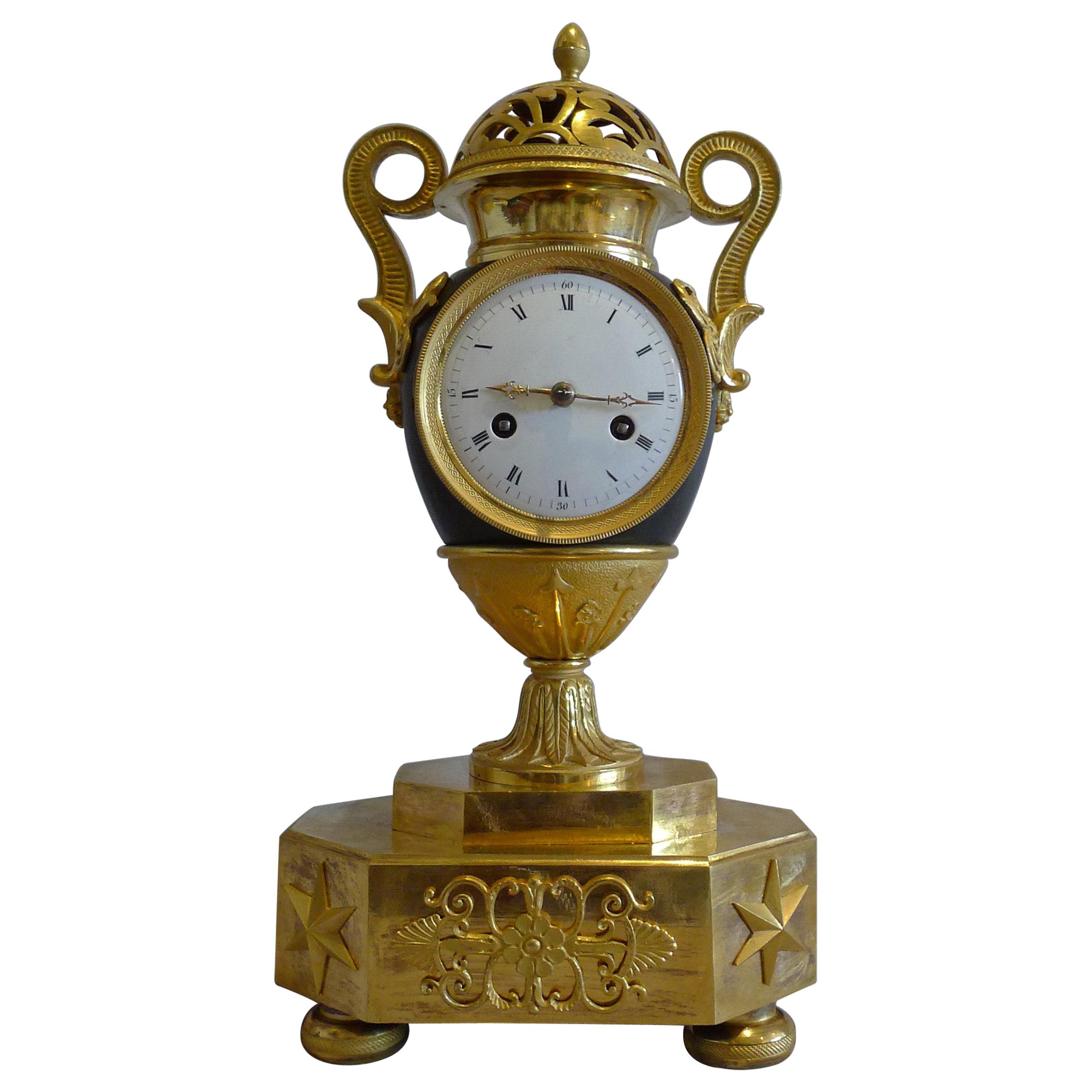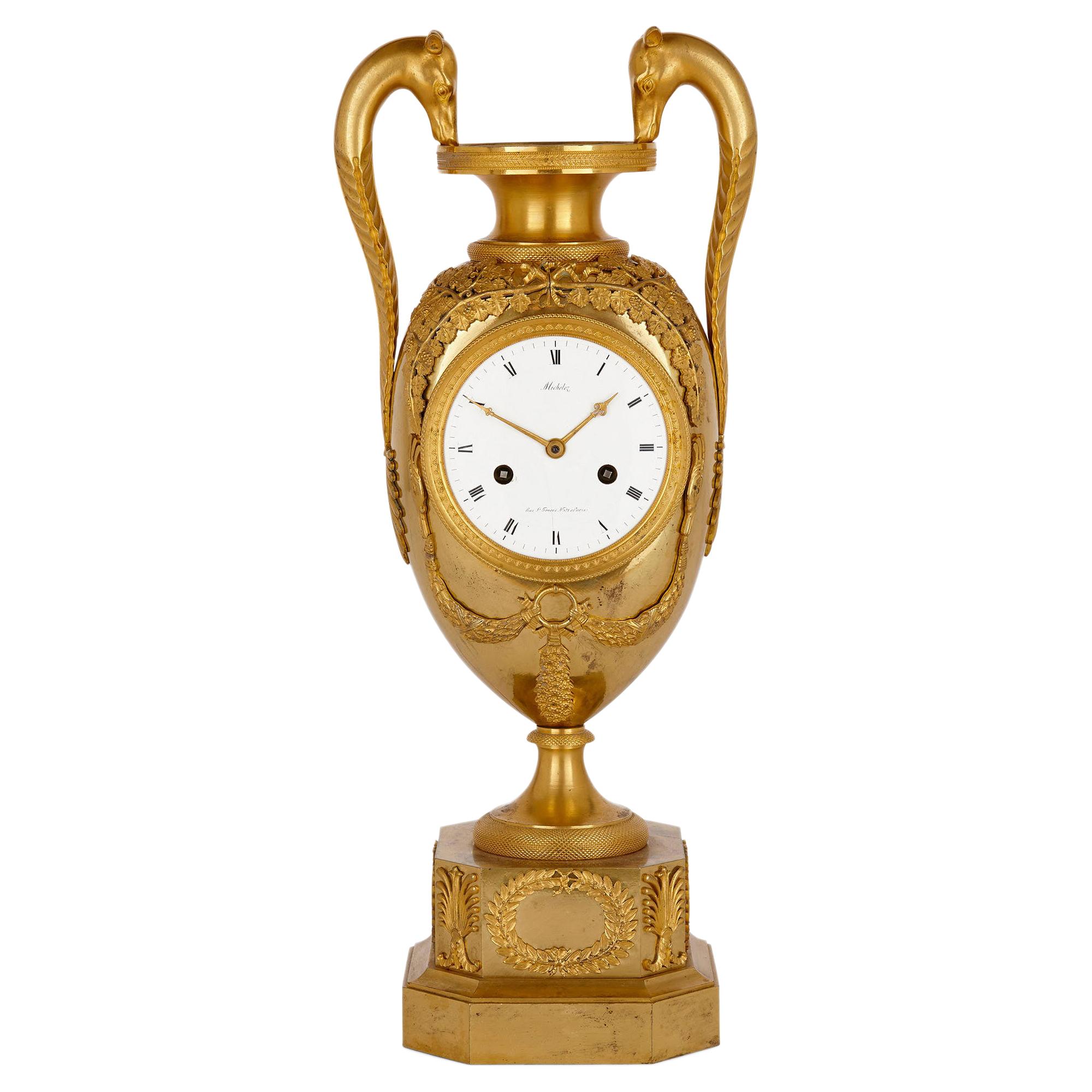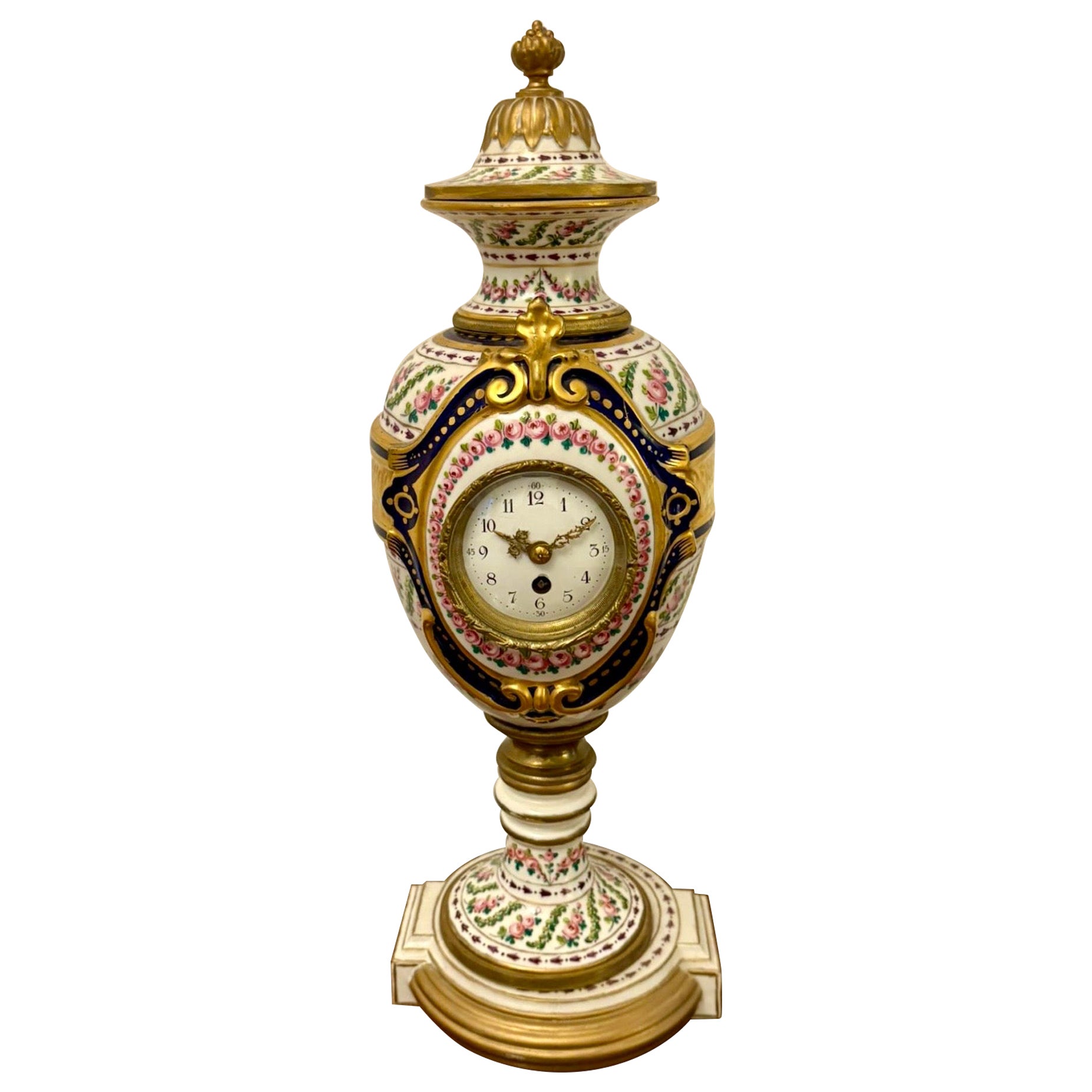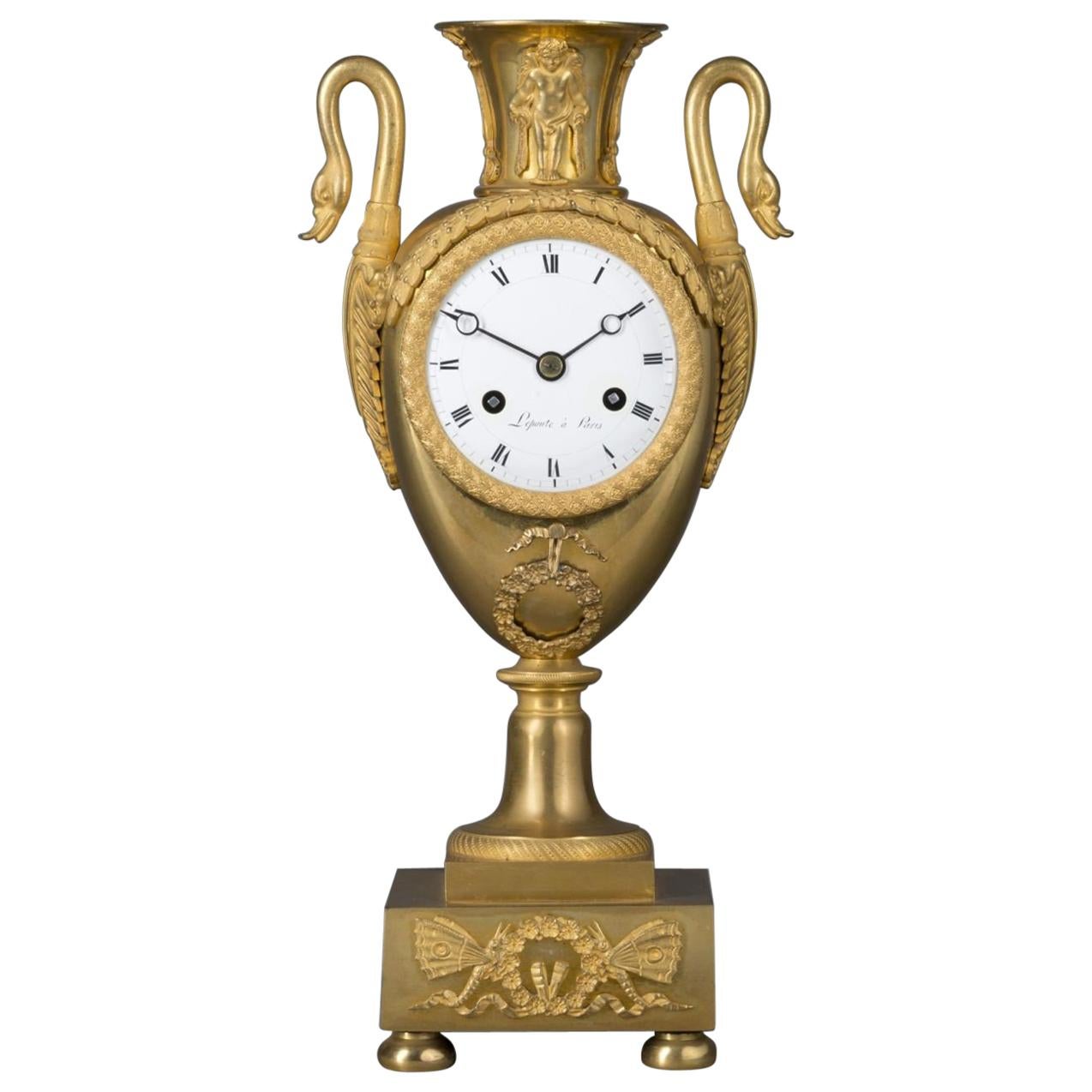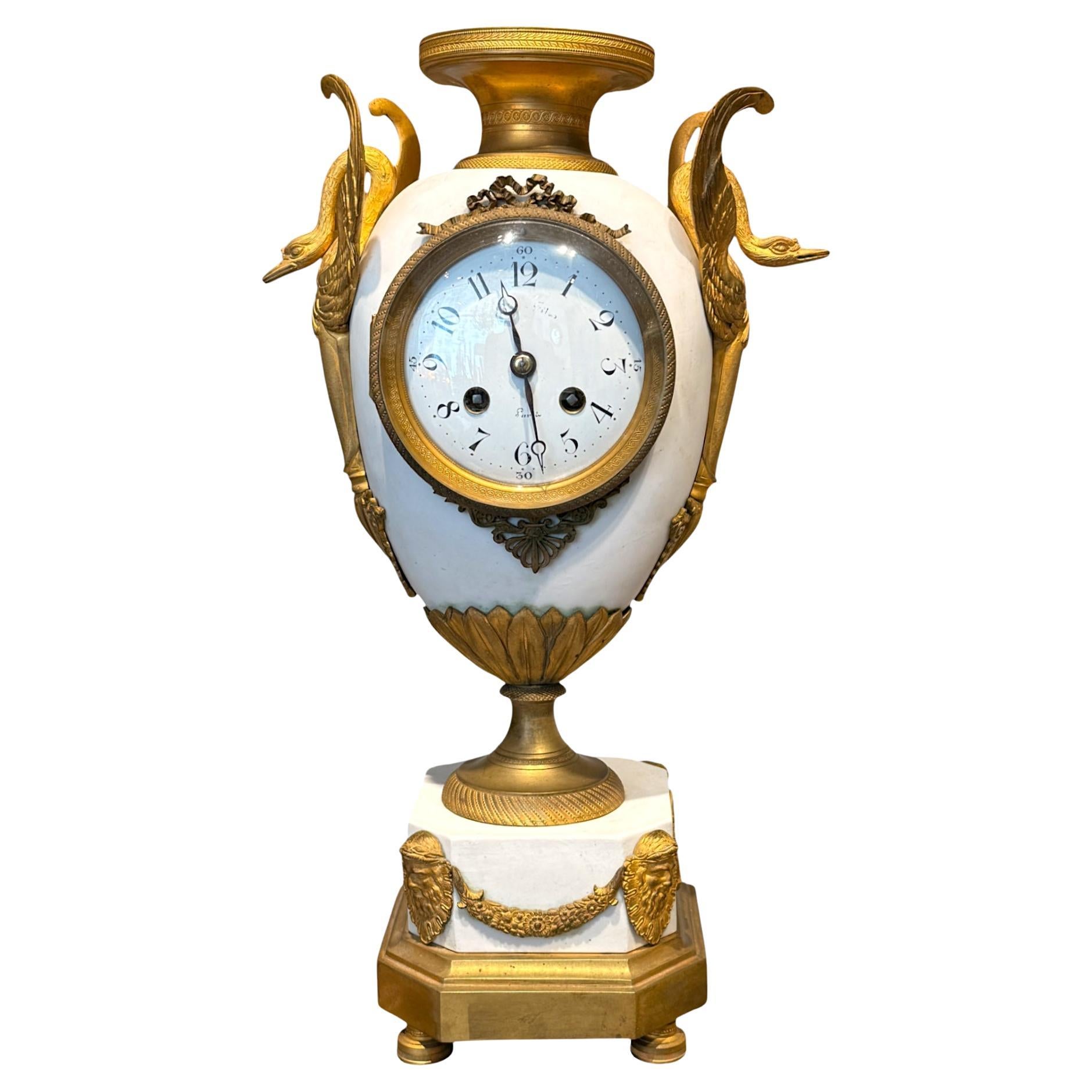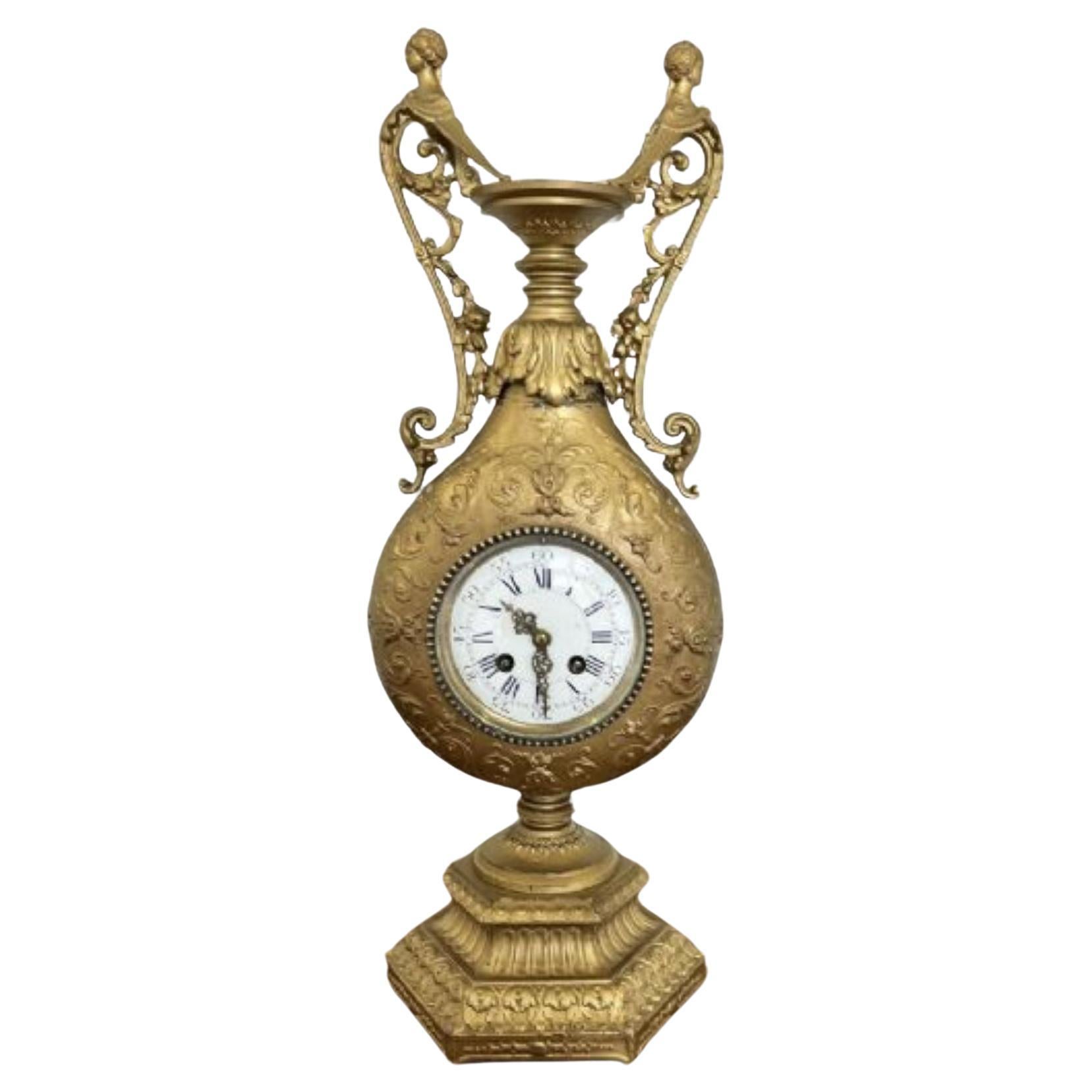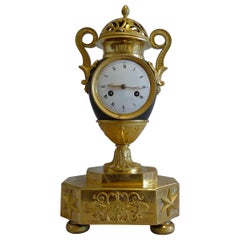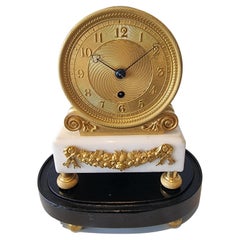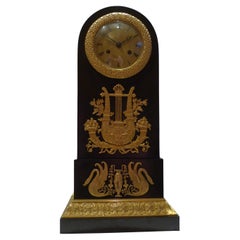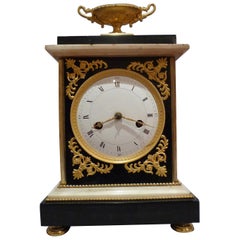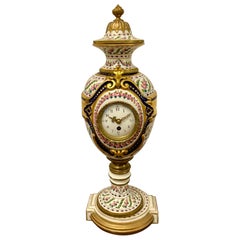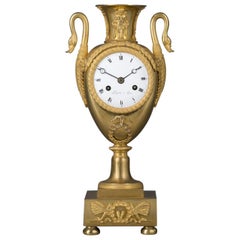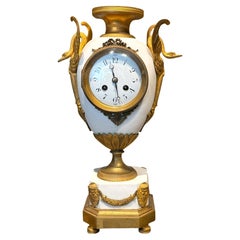Items Similar to French Empire vine orientated vase clock signed Blanc Fils
Want more images or videos?
Request additional images or videos from the seller
1 of 6
French Empire vine orientated vase clock signed Blanc Fils
$5,955.58
£4,250
€5,051.47
CA$8,106.14
A$9,067.23
CHF 4,718.64
MX$111,620.71
NOK 60,030.88
SEK 56,320.80
DKK 37,688.99
Shipping
Retrieving quote...The 1stDibs Promise:
Authenticity Guarantee,
Money-Back Guarantee,
24-Hour Cancellation
About the Item
A fine French Empire vase or urn clock in patinated bronze and fire/ mercury gilt ormolu. With berry finial, fine Bacchus mounts to the shoulders of the vase and vine leaves and grapes surrounding the top of the clock there is no doubt that this clock celebrates the vine. Fine white convex enamel dial signed Blanc Fils a Paris. Patinated bronze hands. Large flat bottomed plate movement striking the hours and halves on a bell by means of the countwheel and regulated by a silk suspended pendulum. Movement numbered 597
- Dimensions:Height: 17 in (43.18 cm)Width: 5.5 in (13.97 cm)Depth: 5.5 in (13.97 cm)
- Materials and Techniques:
- Place of Origin:
- Period:
- Date of Manufacture:1810
- Condition:Wear consistent with age and use.
- Seller Location:London, GB
- Reference Number:1stDibs: LU2015332028152
About the Seller
4.7
Vetted Professional Seller
Every seller passes strict standards for authenticity and reliability
Established in 2012
1stDibs seller since 2016
89 sales on 1stDibs
Typical response time: 1 to 2 days
- ShippingRetrieving quote...Shipping from: London, United Kingdom
- Return Policy
Authenticity Guarantee
In the unlikely event there’s an issue with an item’s authenticity, contact us within 1 year for a full refund. DetailsMoney-Back Guarantee
If your item is not as described, is damaged in transit, or does not arrive, contact us within 7 days for a full refund. Details24-Hour Cancellation
You have a 24-hour grace period in which to reconsider your purchase, with no questions asked.Vetted Professional Sellers
Our world-class sellers must adhere to strict standards for service and quality, maintaining the integrity of our listings.Price-Match Guarantee
If you find that a seller listed the same item for a lower price elsewhere, we’ll match it.Trusted Global Delivery
Our best-in-class carrier network provides specialized shipping options worldwide, including custom delivery.More From This Seller
View AllFrench Empire Patinated Bronze and Ormolu Vase Clock
Located in London, GB
French Empire patinated bronze and ormolu vase clock. Of unusual design set as it is on a spread ormolu base of eight sides, the front and back being long sides. The base sits upon f...
Category
Antique 1810s French Empire Mantel Clocks
Materials
Bronze, Ormolu
English Regency Fusee Mantel Clock in Ormolu and White Marble by Finer and Nowla
Located in London, GB
English Regency ormolu and white marble drum mantel clock. Typical drum shaped clock, set on four elaborate ormolu toupee feet. The white marble has an applied ormolu mount of flower...
Category
Antique 1820s English Mantel Clocks
Materials
Carrara Marble, Ormolu
French Mantel Clock of Empire Period of "Borne" Form
Located in London, GB
Attractive french Empire clock in patinated bronze and ormolu of milestone or "borne" form. Having very fine applied ormolu mounts to the front and side of the case with also a fine ...
Category
Antique 1810s French Mantel Clocks
Materials
Bronze, Ormolu
French Directoire Marble and Ormolu Mantel Clock
Located in London, GB
French Directoire period mantel clock. Constructed of black marble with white statuary marble mouldings with fire gilt/mercury ormolu touches such as ...
Category
Antique 1810s French Mantel Clocks
Materials
Belgian Black Marble, Carrara Marble, Ormolu
French Charles X Period Porcelain Borne Clock
Located in London, GB
A most unusual Paris porcelain clock in the borne form from the Charles X period. Case probably by Jacob Petit with all over decoration in cream ...
Category
Antique 1820s French Mantel Clocks
Materials
Porcelain
French Empire Antique Clock, Ormolu, Patinated Bronze and Marble
By L. Ravrio 1
Located in London, GB
French Empire clock of stunning quality of borne shape constructed of rouge marble, original fire gilt ormolu and patinated bronze. The dial of the clock is signed "L Ravrio" below 1...
Category
Antique Early 1800s French Empire Mantel Clocks
Materials
Marble, Bronze, Ormolu
You May Also Like
French Empire Period Ormolu Mantel Clock by Michelez
Located in London, GB
French Empire period ormolu mantel clock by Michelez
French, circa 1815
Measures: Height 47cm, width 20cm, depth 15cm
This beautifully formed and crafted mantel clock, dating to...
Category
Antique Early 19th Century French Empire Mantel Clocks
Materials
Ormolu, Bronze
Outstanding Quality Large French Antique Hand Painted Porcelain Mantel Clock
Located in Suffolk, GB
Outstanding quality large French antique Victorian hand painted porcelain urn shaped mantle clock having a magnificent quality hand painted porcelain case in the shape of an urn with...
Category
Antique 19th Century French Victorian Mantel Clocks
Materials
Ceramic
Empire Clock in the Form of a Classical Urn, by Maison Lepautre, circa 1825
By Pierre-Basile Lepaute
Located in Brighton, West Sussex
A gilt bronze Empire clock in the form of a classical urn, by Maison Lepautre.
French, circa 1825.
The dial signed 'Lepaute a Paris'.
The clock has an ornate cast bezel with a 3-inch porcelain dial with Roman numerals and Breguet style hands. The twin train eight-day movement with outside count wheel striking on a bell and silk thread suspension.
This elegant Empire style clock has a gilt bronze case in the form of a classical urn with swan neck handles and a winged cherub to the neck. The circular pedestal base is raised on a footed stepped square plinth.
The Lepaute family were the premier French clockmakers of their day. Their significance lies in their contribution to the clock making industry which had hitherto come under the trade of locksmiths. The family held the brevet Horlogers du Roi.
Jean-André Lepaute (1720–1789) arrived in Paris at an early age and in 1740 founded the family business. A skilled artist and mechanic, he quickly gained an excellent reputation. He was received as maître by the clockmakers guild in 1759, was granted royal lodgings from the king in The Luxembourg Palace, and was entrusted with the construction of the majority of the great public clocks of Paris. He executed, amongst others, those in The Luxembourg Palace, the Jardin des Plantes, the Château de Bellevue and the Château des Ternes. His clock at Paris’s École Militaire still works today. Three editions of his Traité d’Horlogerie were published in Paris in 1755, 1760 and 1767. A small volume, Description de Plusieurs Ouvrages d’Horlogerie appeared in 1764. Jean-André’s wife, Nicole-Reine Etable de la Brière (1723-1788), was a highly esteemed mathematician and astronomer. Her passion for science lent itself to Lepaute’s work and she played an active role in the scientific and mathematical aspects of the clock making.
Jean-André’s younger brother Jean-Baptiste Lepaute (1727-1802) joined him in Paris in 1747 and immediately started working for the family business. He was received as maître in 1776 and was known for the clocks he constructed for the Paris Hôtel de Ville (1780), destroyed in a fire of 1871, and for the Hôtel des Invalides (1784). Jean-Baptiste took over the workshop when Jean-André retired in 1775.
After Jean-Baptiste’s death in 1802, the firm was taken over by his nephew Pierre-Basil Lepaute (1750-1843) where he was duly joined by his own nephew Jean-Joseph (1768-1846) and son Pierre-Michel (1785-1849). By 1816, Pierre-Michel Lepaute was in charge of the business. His masterpieces include the astronomical clock in Paris’s Bureau...
Category
Antique Early 19th Century French Empire Mantel Clocks
Materials
Bronze
French Louis XVI Style biscuit and Gilt Bronze Mantel Clock, 19t Century
Located in NICE, FR
19th Century French Biscuit and Gilt Bronze Mantel Clock – “Pendule en Biscuit aux Cygnes et aux Masques d’Hercule”
A 19th-century French mantel clock, crafted in the form of a clas...
Category
Antique Late 19th Century French Empire Mantel Clocks
Materials
Bronze
Fantastic quality antique Victorian French ornate Mantle Clock
Located in Ipswich, GB
Fantastic quality antique Victorian French ornate eight day striking mantle clock, having a quality gilded ornate shape case, shaped handles with ornate figures to the top, standing ...
Category
Antique Early 19th Century Victorian Mantel Clocks
Materials
Brass
French Sevres style porcelain vase / mantel clock.
Located in Brighton, Sussex
A very good quality late 19th Century French Sevres style porcelain lidded vase / clock. Having wonderful gilded ormolu mounts, a cherub finial and monopodia handles, an enamel faced...
Category
Antique Late 19th Century French Mantel Clocks
Materials
Porcelain
More Ways To Browse
Grape Vine French
French Empire Vases
Grape Vine Vase
Bacchus Vase
Bacchus Urn
Mercury Pendulum Clock
Mercury Pendulum
Bacchus Clock
Pendule Empire
Roman Roundels
Antique Victorian Mantle Clock
Astronomical Clock
Chariot Clock
Marble Clock Urn Garniture
Marble Lyre Clocks
Psyche Bronze 19th Century French
Watch Display Case
Antique Bronze Gong
